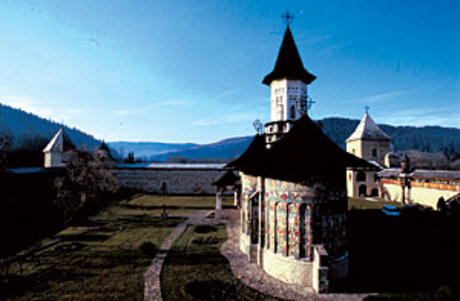Sucevita Church
The church of the Sucevita Monastery was included on the UNESCO Heritage List on 1 August 2010 and is the only church that includes a representation of The Ladder of St. John. This classic Moldavian church with its five rooms, shows the first new architectural tendencies: smaller niches, and three bases for the tower. The frescoes are very remarkable, colourful and well preserved.
Three Movilă brothers built the Church of the Resurrection of Suceviţa around 1583. The church is the only painted church that was not founded by a ruling prince, although the Movilăs were descendants of Petru Rareş on their mother’s side. Quite soon after the monastery was built Ieremia Movilă became the ruler of Moldavia, and his brother Simion reigned in Walachia. The third brother, Gheorghe, who was during that period the Bishop of Rădăuţi, rose to become the Metropolitan of Moldavia.
The church was painted around 1595, nearly half a century after its “sister” churches. It is considered the last flowering of the custom of painting the church façades that mark the reigns of Stephen the Great and Petru Rareş. Building and painting a church that closely resembled the edifices their ancestors raised decades before, was a way for the Movilăs to claim to be part of the royal line of Stephen the Great.
At the same time, though, the monastic compound of Suceviţa and its buildings herald the architectural innovations of the following century.
The massive precinct walls were built after 1595, during the reign of Ieremia Movilă. Each wall is nearly 100 metres long, three metres wide and more than six metres tall, and create the atmosphere of a mediaeval fortress. The walls are strengthened with buttresses, bulwarks and imposing towers. Narrow loopholes in the upper part of the walls indicate that a defensive catwalk encircled the compound.
Each of the five towers has a different plan. The square gate tower with its pointed octagonal turret is in the middle of the north wall. A vaulted gateway, with heavy buttresses on either side, leads through to the compound. Above the arch of the gateway is a semicircular niche with a painting of The Resurrection and the carved coat of arms of Moldavia. Above the gateway, there are two storeys with rooms.
On the first floor is a small chapel dedicated to the Annunciation. The northwest tower is the bell tower of the monastery. It is the most massive one of them all, with three three-tiered buttresses on the outside. The buttresses were added later, as were the gate tower buttresses. On the ground floor is a small laboratory for the restoration of icons, where trained nuns work. On the top floor is the belfry with four big arched openings. The two bells that Ieremia Movilă donated in 1605 are still used daily. The other three towers are octagonal but each different from the other: the northeast tower has three storeys, the southeast five and the southwest two.
A wooden glazed gallery was built on the north wall during the 19th century.The slender wooden turret has the date 1867 carved on it.The existing monastic buildings abut the east wall. The central part is original, and houses, besides the nuns’ cells, a museum with embroideries, manuscripts, religious objects and icons. The Church of the Resurrection, although still built on the model of the classic Moldavian church, shows the first new architectural tendencies.
The church has the five rooms of a large Moldavian monastery church: the chancel, naos, burial chamber, pronaos and exonarthex. On the apses are tall niches, but they no longer reach nearly to the eaves as before. The row of small niches that used to go around the church façades has been omitted. The tower is for the first time placed on three bases, a practice that was followed some years later in Dragomirna. On either side of the exonarthex are two small open porches of Walachian influence.




